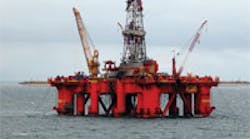As easy-to-reach sources of oil and gas dry-up, energy companies must find new sources in progressively deeper waters. It is now commonplace for offshore drilling to descend to 10,000 ft or more to tap into newly discovered reserves. With deeper drilling comes greater challenges in operating drilling equipment. Among the challenges are very high ambient pressures at these depths, saltwater corrosion, extreme temperatures, and the difficulties of operating equipment two miles below sea level.
It’s a blowout
When drilling on land or offshore, operators must be wary of pockets of high-pressure gas that may be entrained in the oil, shale, or other geological formation. In some cases, the formation may contain dangerously high amounts of gas that can cause a kick (a bubble of explosive gas), which cannot be easily trapped or burned off. This is the major cause of oil well blowouts.
Blowouts strike safety and economic terror into the hearts of drilling contractors. If even one spark is present, a serious fire is ensured. Additionally, the loss of production time, equipment, and environmental considerations make controlling these events critical. Financial losses can quickly escalate well into the millions. To prevent blowouts, gases must be safely vented or burned off. To do this, enormous valves — collectively called blowout preventers (BOPs) — are installed on all drilling wellheads.
Each BOP is equipped with quick-reacting hydraulic rams that extend to block the escape of high-pressure gas. BOPs require large volumes of high pressure fluid that must be delivered instantly. BOP hydraulic power units were developed to operate these valves by pressurizing accumulators, which store fluid energy that can be instantly released to close the drill pipe coming out of the sea floor.
A BOP located on the sea floor typically operates internally at hydraulic pressure of 5000 psi, plus the hydrostatic pressure, and has accumulators with a high precharge of nitrogen gas. With only seconds to react, bladder accumulators — with their enormous power reserve, flow rate, and available volume — have proven highly reliable.
But there is a problem. A BOP’s hydraulic power unit and fluid reservoir typically are located at sea level. However, the accumulators and associated hydraulic controls for the BOP are mounted on a subsea subassembly (called a stack), which contains the actual BOP valve. On the surface, the accumulators are precharged with nitrogen gas to a pressure not exceeding the maximum allowable working pressure.
The stack is lowered to the drilling depth, and if the drilling site lies deeper than 10,000 ft of water, the hydrostatic pressure will exceed 5000 psi. At that depth, colder temperatures reduce the nitrogen precharge in the accumulators, but the hydraulic fluid must be pumped into the accumulator at the correct working pressure and with the hydrostatic pressure taken into consideration. Consequently, with the actual operating pressure at 10,000 psi, and a reduced precharge from colder temperatures, only a small percentage of the nominal volume contains usable pressurized fluid!
Meeting the challenge
Limitations of manufacturing technologies and material strength historically had limited the maximum operating pressure of bladder accumulators to 6000 psi. This necessitated the complicated procedures just described. However, because bladder accumulators have had an excellent performance and safety record for more than half a century and are cost effective and can be readily repaired in the field, they are the clear choice of oil rig operators.
A solution to simplify operations was recently introduced by Accumulators, Inc. Houston, with its line of 10,000 psi, seamless shell bladder accumulators sized from 212 to 15 gal. As a result, drilling contractors can now precharge accumulators up to 10,000 psi at sea level. This can shave days off setup time, allow for higher operating pressures, and increase efficiency, which equates to more usable fluid at current high operating pressures. All this means operational cost savings.
The 10,000 psi bladder accumulator has a seamless shell made of CrMo steel. The shell has an external marine epoxy coating and internal phenolic coating to help provide lubricity for the water-based hydraulic fluid used in all subsea control systems. Fluid port connections and gas end connections are all stainless steel for corrosion resistance. This combination of high-tech materials has already been used successfully in 6000-psi subsea accumulators for years. New elastomers with a wide temperature range improve bladder operation and longevity.
Typical fluid ports are 1-in. medium pressure female connections rated for operating pressure to 15,000 psi. All models are available with proper approvals for offshore and subsea service as dictated by the jurisdiction where the actual drilling rig will be located.
For more information on 10,000-psi accumulators, call Rick Kendall at (713) 465-0202, e-mail [email protected] or visit www.accumulators.com.



